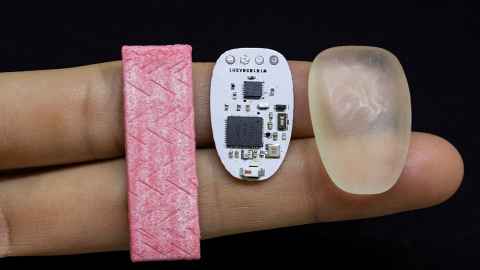The interactive device you can stick in your mouth
19 February 2019
Imagine a device that feels like and is no bigger than a piece of chewing gum, which allows you to answer the phone simply by biting down on it.

We now have the technology to do that, with ChewIt, a novel interface developed by the Augmented Human Lab team at the Auckland Bioengineering Institute (ABI), University of Auckland.
It’s a tiny piece of technology encased in a flexible custom-made PCB that you pop in your mouth and which allows for discreet and hands-free interaction with your phone, your computer, your smartwatch and so on.
ChewIt was developed by the team led by Associate Professor Suranga Nanayakkara who made international headlines in recent years with the FingerReader, a prototype device worn on the finger that allows users to point at words (those on the spine of the book, or in a restaurant menu) which is then translated to voice.
Since moving from Singapore to New Zealand last year, Nanayakkara and his team have produced a number of innovative technologies.
Along with ChewIt they have also developed GymSoles, a pressure sensitive insole that vibrates, giving users vibrotactile feedback to help them maintain the correct body posture.
Nanayakkara has an almost philosophical approach to technology. He wants to address what he says is a mismatch between what technology has to offer and innate human behaviour, and develop technologies that are more responsive to innate human behaviour rather than oblige humans to adjust to the requirements of the technology.
“We want to design and develop systems that can understand the user rather than us having to tell the technology what to do every time – technologies that can understand us much better than technology currently does.”
He defines such technologies as ‘assistive augmentation’. “It’s when the system understands the abilities, behaviour and emotions of the user. And when the system is unobtrusive and integrated with our body or our behaviour.
“And it should be about strengthening and extending the physical and sensorial abilities of the user, allowing them to do what they couldn’t do before. When you meet all three measures, that’s assistive augmentation.”
Media contact
Margo White | Media Adviser
Tel 09 923 5504
Mob 021 926 408
Email margo.white@auckland.ac.nz